Mental Health in International Students: A Comprehensive Report
VerifiedAdded on 2022/08/19
|10
|2446
|13
Report
AI Summary
This report examines the increasing mental health issues among international students, particularly in Australia. It highlights factors such as unfamiliar environments, cultural differences, language barriers, and isolation as significant contributors to psychological distress. The report analyzes several annotated studies, including journal articles and research papers, which explore the prevalence of mental health disorders, the reluctance of international students to seek help, and the need for inclusive curricula and personalized care. The studies compare international students to domestic students, revealing higher risks for mental health conditions and lower rates of help-seeking behavior. The report emphasizes the importance of early intervention programs, culturally sensitive support, and awareness campaigns to improve the well-being and educational outcomes of international students. The analysis includes strengths and weaknesses of each study, providing a comprehensive overview of the challenges and potential solutions.
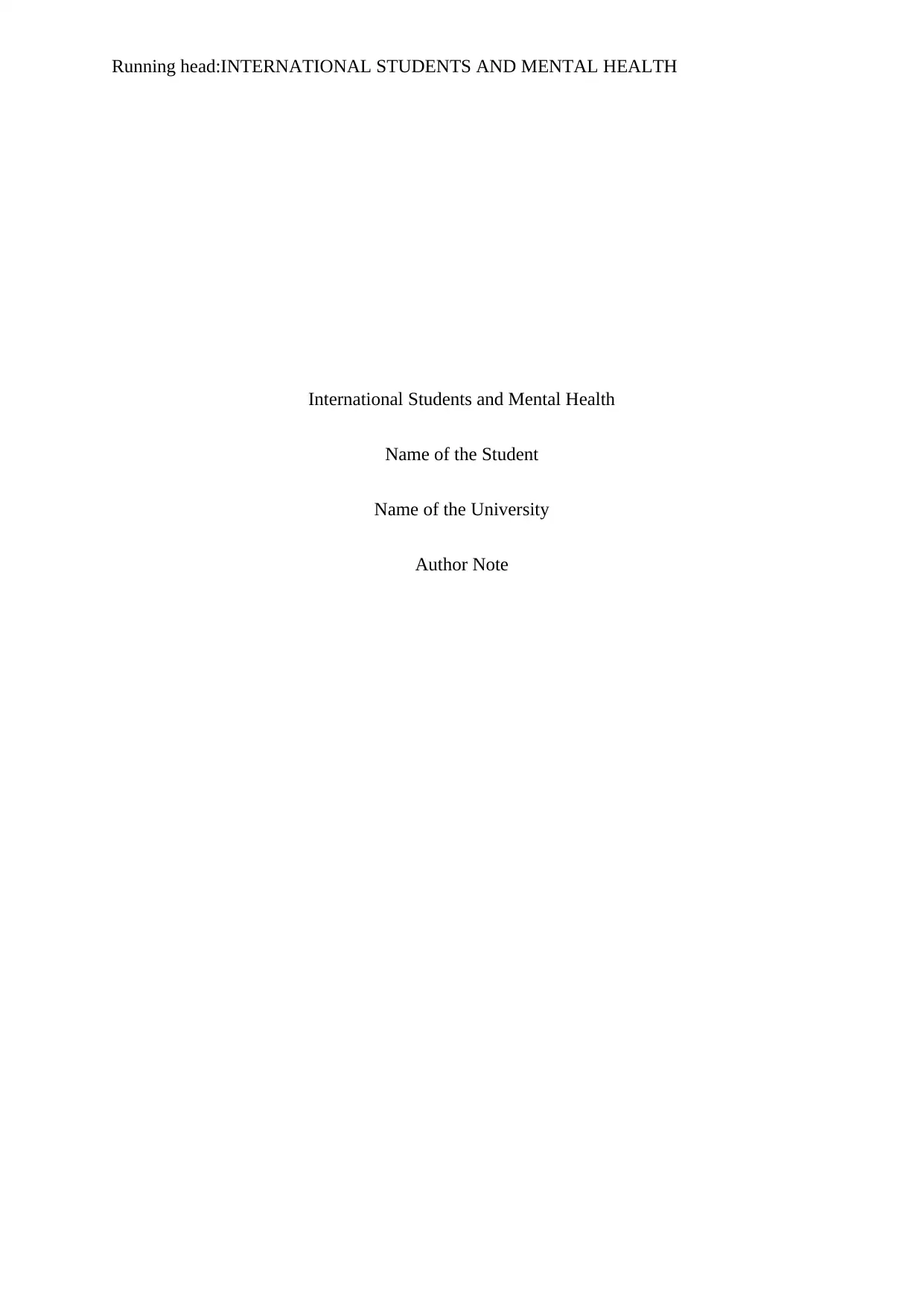
Running head:INTERNATIONAL STUDENTS AND MENTAL HEALTH
International Students and Mental Health
Name of the Student
Name of the University
Author Note
International Students and Mental Health
Name of the Student
Name of the University
Author Note
Paraphrase This Document
Need a fresh take? Get an instant paraphrase of this document with our AI Paraphraser
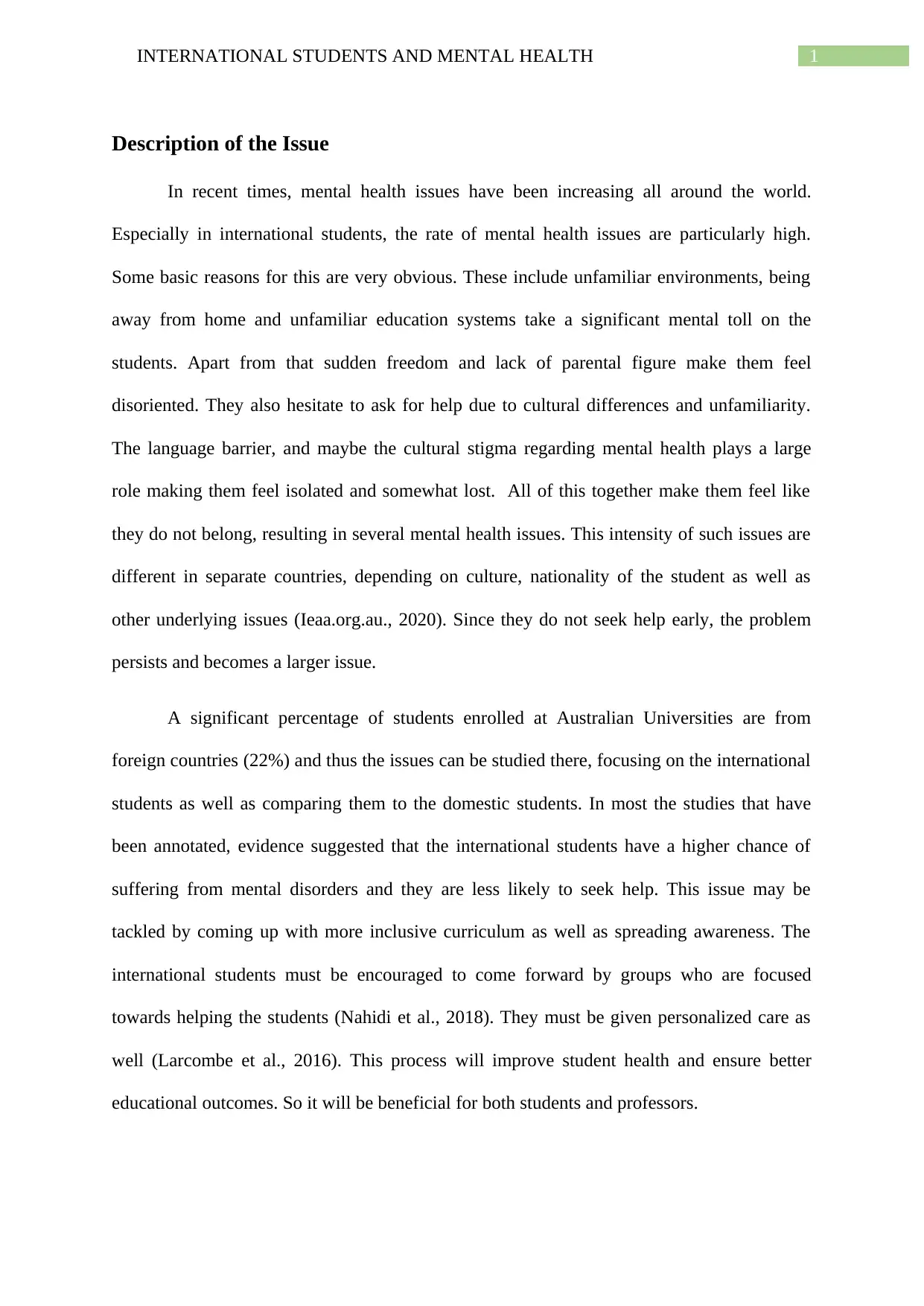
1INTERNATIONAL STUDENTS AND MENTAL HEALTH
Description of the Issue
In recent times, mental health issues have been increasing all around the world.
Especially in international students, the rate of mental health issues are particularly high.
Some basic reasons for this are very obvious. These include unfamiliar environments, being
away from home and unfamiliar education systems take a significant mental toll on the
students. Apart from that sudden freedom and lack of parental figure make them feel
disoriented. They also hesitate to ask for help due to cultural differences and unfamiliarity.
The language barrier, and maybe the cultural stigma regarding mental health plays a large
role making them feel isolated and somewhat lost. All of this together make them feel like
they do not belong, resulting in several mental health issues. This intensity of such issues are
different in separate countries, depending on culture, nationality of the student as well as
other underlying issues (Ieaa.org.au., 2020). Since they do not seek help early, the problem
persists and becomes a larger issue.
A significant percentage of students enrolled at Australian Universities are from
foreign countries (22%) and thus the issues can be studied there, focusing on the international
students as well as comparing them to the domestic students. In most the studies that have
been annotated, evidence suggested that the international students have a higher chance of
suffering from mental disorders and they are less likely to seek help. This issue may be
tackled by coming up with more inclusive curriculum as well as spreading awareness. The
international students must be encouraged to come forward by groups who are focused
towards helping the students (Nahidi et al., 2018). They must be given personalized care as
well (Larcombe et al., 2016). This process will improve student health and ensure better
educational outcomes. So it will be beneficial for both students and professors.
Description of the Issue
In recent times, mental health issues have been increasing all around the world.
Especially in international students, the rate of mental health issues are particularly high.
Some basic reasons for this are very obvious. These include unfamiliar environments, being
away from home and unfamiliar education systems take a significant mental toll on the
students. Apart from that sudden freedom and lack of parental figure make them feel
disoriented. They also hesitate to ask for help due to cultural differences and unfamiliarity.
The language barrier, and maybe the cultural stigma regarding mental health plays a large
role making them feel isolated and somewhat lost. All of this together make them feel like
they do not belong, resulting in several mental health issues. This intensity of such issues are
different in separate countries, depending on culture, nationality of the student as well as
other underlying issues (Ieaa.org.au., 2020). Since they do not seek help early, the problem
persists and becomes a larger issue.
A significant percentage of students enrolled at Australian Universities are from
foreign countries (22%) and thus the issues can be studied there, focusing on the international
students as well as comparing them to the domestic students. In most the studies that have
been annotated, evidence suggested that the international students have a higher chance of
suffering from mental disorders and they are less likely to seek help. This issue may be
tackled by coming up with more inclusive curriculum as well as spreading awareness. The
international students must be encouraged to come forward by groups who are focused
towards helping the students (Nahidi et al., 2018). They must be given personalized care as
well (Larcombe et al., 2016). This process will improve student health and ensure better
educational outcomes. So it will be beneficial for both students and professors.
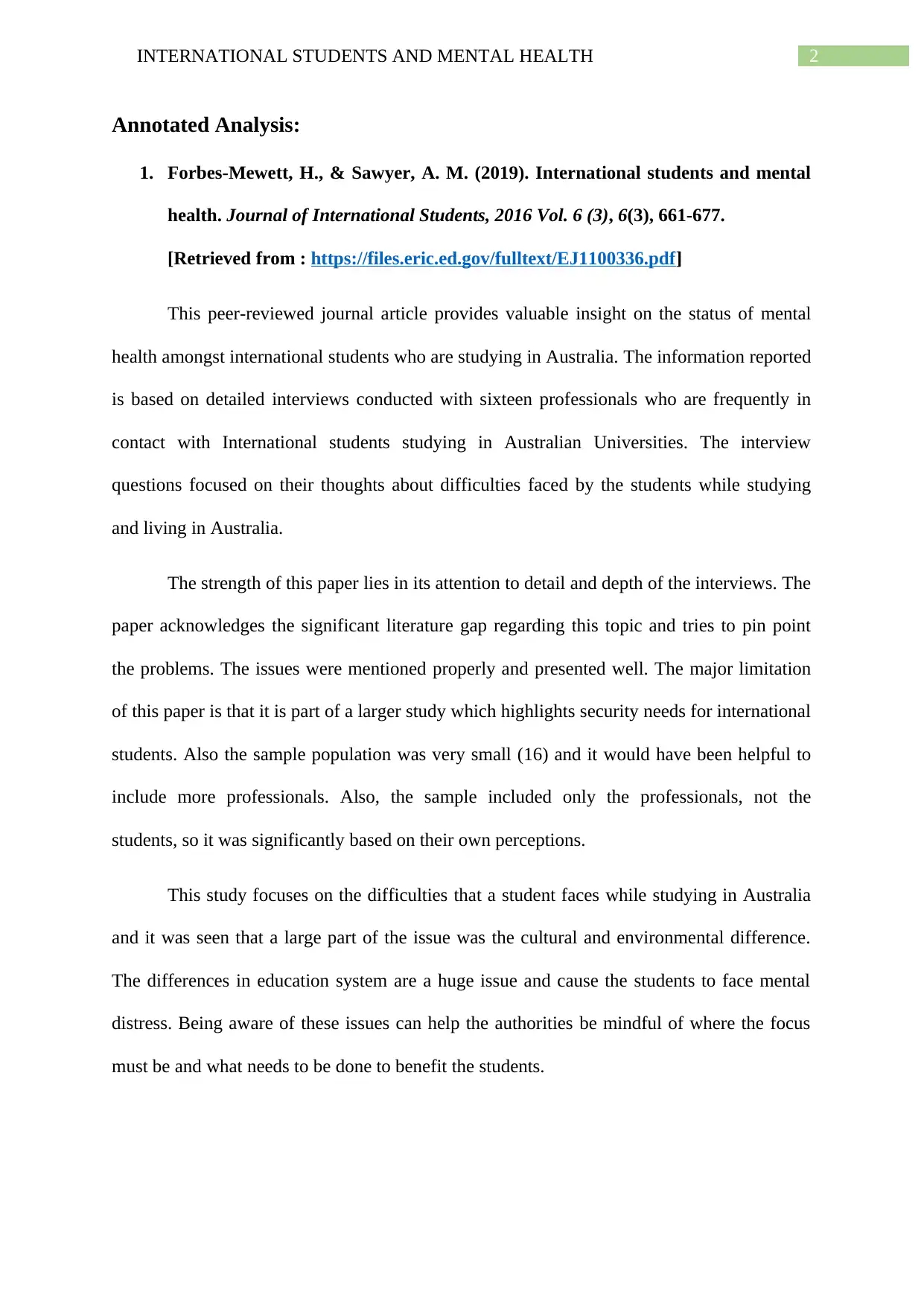
2INTERNATIONAL STUDENTS AND MENTAL HEALTH
Annotated Analysis:
1. Forbes-Mewett, H., & Sawyer, A. M. (2019). International students and mental
health. Journal of International Students, 2016 Vol. 6 (3), 6(3), 661-677.
[Retrieved from : https://files.eric.ed.gov/fulltext/EJ1100336.pdf]
This peer-reviewed journal article provides valuable insight on the status of mental
health amongst international students who are studying in Australia. The information reported
is based on detailed interviews conducted with sixteen professionals who are frequently in
contact with International students studying in Australian Universities. The interview
questions focused on their thoughts about difficulties faced by the students while studying
and living in Australia.
The strength of this paper lies in its attention to detail and depth of the interviews. The
paper acknowledges the significant literature gap regarding this topic and tries to pin point
the problems. The issues were mentioned properly and presented well. The major limitation
of this paper is that it is part of a larger study which highlights security needs for international
students. Also the sample population was very small (16) and it would have been helpful to
include more professionals. Also, the sample included only the professionals, not the
students, so it was significantly based on their own perceptions.
This study focuses on the difficulties that a student faces while studying in Australia
and it was seen that a large part of the issue was the cultural and environmental difference.
The differences in education system are a huge issue and cause the students to face mental
distress. Being aware of these issues can help the authorities be mindful of where the focus
must be and what needs to be done to benefit the students.
Annotated Analysis:
1. Forbes-Mewett, H., & Sawyer, A. M. (2019). International students and mental
health. Journal of International Students, 2016 Vol. 6 (3), 6(3), 661-677.
[Retrieved from : https://files.eric.ed.gov/fulltext/EJ1100336.pdf]
This peer-reviewed journal article provides valuable insight on the status of mental
health amongst international students who are studying in Australia. The information reported
is based on detailed interviews conducted with sixteen professionals who are frequently in
contact with International students studying in Australian Universities. The interview
questions focused on their thoughts about difficulties faced by the students while studying
and living in Australia.
The strength of this paper lies in its attention to detail and depth of the interviews. The
paper acknowledges the significant literature gap regarding this topic and tries to pin point
the problems. The issues were mentioned properly and presented well. The major limitation
of this paper is that it is part of a larger study which highlights security needs for international
students. Also the sample population was very small (16) and it would have been helpful to
include more professionals. Also, the sample included only the professionals, not the
students, so it was significantly based on their own perceptions.
This study focuses on the difficulties that a student faces while studying in Australia
and it was seen that a large part of the issue was the cultural and environmental difference.
The differences in education system are a huge issue and cause the students to face mental
distress. Being aware of these issues can help the authorities be mindful of where the focus
must be and what needs to be done to benefit the students.
⊘ This is a preview!⊘
Do you want full access?
Subscribe today to unlock all pages.

Trusted by 1+ million students worldwide

3INTERNATIONAL STUDENTS AND MENTAL HEALTH
2. Nahidi, S., Blignault, I., Hayen, A., & Razee, H. (2018). Psychological distress in
Iranian international students at an Australian university. Journal of immigrant
and minority health, 20(3), 651-657.
[Retrieved from
https://www.researchgate.net/profile/Shizar_Nahidi/publication/316689931_Psyc
hological_Distress_in_Iranian_International_Students_at_an_Australian_Univer
sity/links/5c3c1750458515a4c72481e0/Psychological-Distress-in-Iranian-
International-Students-at-an-Australian-University.pdf]
The purpose of this original paper is to research and highlight the mental health status
of Iranian students who were pursuing different degrees in Australian universities. A total of
180 students participated in this study by filling up an email questionnaire which included
questions about socio-demographic items and five scales that were validated to measure
psychological distress.
The strength of this paper is that the data is presented in a very organized way. The
method is explained in detail which helps the reader understand it perfectly. Since the study
was targeted towards a culturally specific sample population, it ensured that the response rate
was maximized. The sample population represented the Iranian student population in
Australia thus was considered to be accurate. The limitation of the study is that the students
who participated were mostly notified through IRANSA and social media. So there is a high
possibility that the study only attracted students who were most connected through social
media and perhaps seeking someone to talk to about their distress.
This studies showed that Iranian female students were most likely to face mental
health problems that that of their male counterparts. The cultural difference often stop them
from seeking help. So it is possible that by pinpointing the issues, student-friendly
2. Nahidi, S., Blignault, I., Hayen, A., & Razee, H. (2018). Psychological distress in
Iranian international students at an Australian university. Journal of immigrant
and minority health, 20(3), 651-657.
[Retrieved from
https://www.researchgate.net/profile/Shizar_Nahidi/publication/316689931_Psyc
hological_Distress_in_Iranian_International_Students_at_an_Australian_Univer
sity/links/5c3c1750458515a4c72481e0/Psychological-Distress-in-Iranian-
International-Students-at-an-Australian-University.pdf]
The purpose of this original paper is to research and highlight the mental health status
of Iranian students who were pursuing different degrees in Australian universities. A total of
180 students participated in this study by filling up an email questionnaire which included
questions about socio-demographic items and five scales that were validated to measure
psychological distress.
The strength of this paper is that the data is presented in a very organized way. The
method is explained in detail which helps the reader understand it perfectly. Since the study
was targeted towards a culturally specific sample population, it ensured that the response rate
was maximized. The sample population represented the Iranian student population in
Australia thus was considered to be accurate. The limitation of the study is that the students
who participated were mostly notified through IRANSA and social media. So there is a high
possibility that the study only attracted students who were most connected through social
media and perhaps seeking someone to talk to about their distress.
This studies showed that Iranian female students were most likely to face mental
health problems that that of their male counterparts. The cultural difference often stop them
from seeking help. So it is possible that by pinpointing the issues, student-friendly
Paraphrase This Document
Need a fresh take? Get an instant paraphrase of this document with our AI Paraphraser
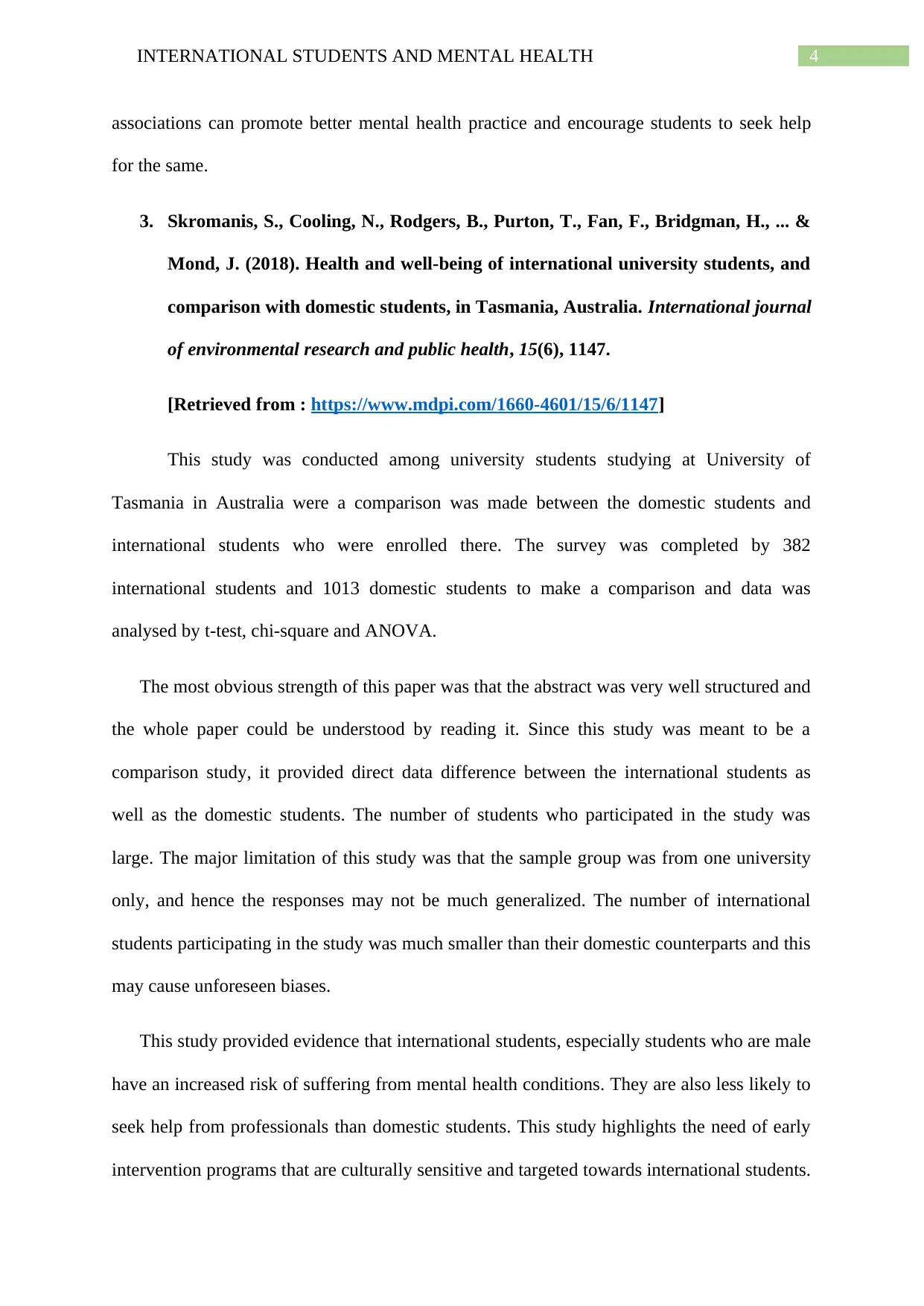
4INTERNATIONAL STUDENTS AND MENTAL HEALTH
associations can promote better mental health practice and encourage students to seek help
for the same.
3. Skromanis, S., Cooling, N., Rodgers, B., Purton, T., Fan, F., Bridgman, H., ... &
Mond, J. (2018). Health and well-being of international university students, and
comparison with domestic students, in Tasmania, Australia. International journal
of environmental research and public health, 15(6), 1147.
[Retrieved from : https://www.mdpi.com/1660-4601/15/6/1147]
This study was conducted among university students studying at University of
Tasmania in Australia were a comparison was made between the domestic students and
international students who were enrolled there. The survey was completed by 382
international students and 1013 domestic students to make a comparison and data was
analysed by t-test, chi-square and ANOVA.
The most obvious strength of this paper was that the abstract was very well structured and
the whole paper could be understood by reading it. Since this study was meant to be a
comparison study, it provided direct data difference between the international students as
well as the domestic students. The number of students who participated in the study was
large. The major limitation of this study was that the sample group was from one university
only, and hence the responses may not be much generalized. The number of international
students participating in the study was much smaller than their domestic counterparts and this
may cause unforeseen biases.
This study provided evidence that international students, especially students who are male
have an increased risk of suffering from mental health conditions. They are also less likely to
seek help from professionals than domestic students. This study highlights the need of early
intervention programs that are culturally sensitive and targeted towards international students.
associations can promote better mental health practice and encourage students to seek help
for the same.
3. Skromanis, S., Cooling, N., Rodgers, B., Purton, T., Fan, F., Bridgman, H., ... &
Mond, J. (2018). Health and well-being of international university students, and
comparison with domestic students, in Tasmania, Australia. International journal
of environmental research and public health, 15(6), 1147.
[Retrieved from : https://www.mdpi.com/1660-4601/15/6/1147]
This study was conducted among university students studying at University of
Tasmania in Australia were a comparison was made between the domestic students and
international students who were enrolled there. The survey was completed by 382
international students and 1013 domestic students to make a comparison and data was
analysed by t-test, chi-square and ANOVA.
The most obvious strength of this paper was that the abstract was very well structured and
the whole paper could be understood by reading it. Since this study was meant to be a
comparison study, it provided direct data difference between the international students as
well as the domestic students. The number of students who participated in the study was
large. The major limitation of this study was that the sample group was from one university
only, and hence the responses may not be much generalized. The number of international
students participating in the study was much smaller than their domestic counterparts and this
may cause unforeseen biases.
This study provided evidence that international students, especially students who are male
have an increased risk of suffering from mental health conditions. They are also less likely to
seek help from professionals than domestic students. This study highlights the need of early
intervention programs that are culturally sensitive and targeted towards international students.
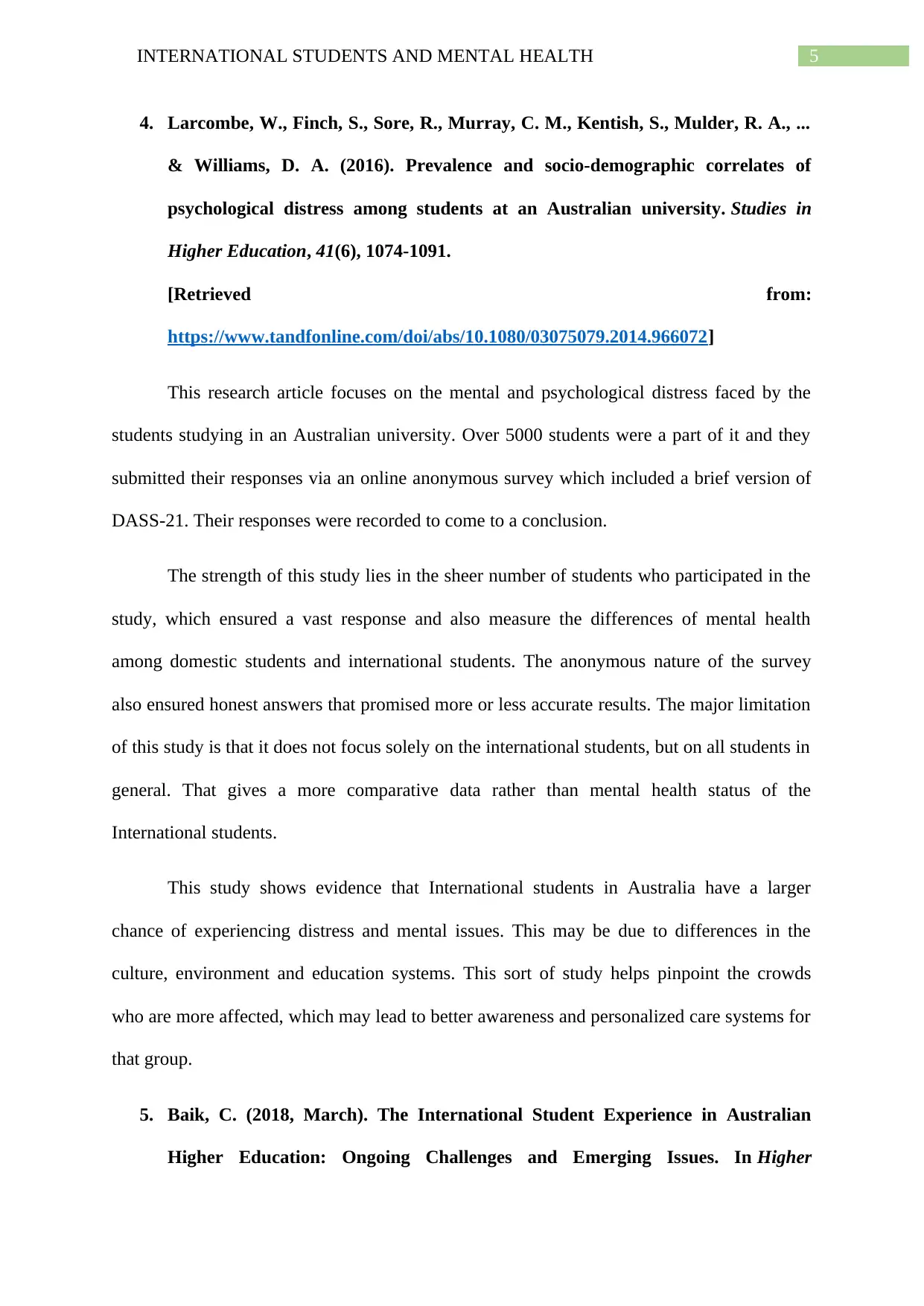
5INTERNATIONAL STUDENTS AND MENTAL HEALTH
4. Larcombe, W., Finch, S., Sore, R., Murray, C. M., Kentish, S., Mulder, R. A., ...
& Williams, D. A. (2016). Prevalence and socio-demographic correlates of
psychological distress among students at an Australian university. Studies in
Higher Education, 41(6), 1074-1091.
[Retrieved from:
https://www.tandfonline.com/doi/abs/10.1080/03075079.2014.966072]
This research article focuses on the mental and psychological distress faced by the
students studying in an Australian university. Over 5000 students were a part of it and they
submitted their responses via an online anonymous survey which included a brief version of
DASS-21. Their responses were recorded to come to a conclusion.
The strength of this study lies in the sheer number of students who participated in the
study, which ensured a vast response and also measure the differences of mental health
among domestic students and international students. The anonymous nature of the survey
also ensured honest answers that promised more or less accurate results. The major limitation
of this study is that it does not focus solely on the international students, but on all students in
general. That gives a more comparative data rather than mental health status of the
International students.
This study shows evidence that International students in Australia have a larger
chance of experiencing distress and mental issues. This may be due to differences in the
culture, environment and education systems. This sort of study helps pinpoint the crowds
who are more affected, which may lead to better awareness and personalized care systems for
that group.
5. Baik, C. (2018, March). The International Student Experience in Australian
Higher Education: Ongoing Challenges and Emerging Issues. In Higher
4. Larcombe, W., Finch, S., Sore, R., Murray, C. M., Kentish, S., Mulder, R. A., ...
& Williams, D. A. (2016). Prevalence and socio-demographic correlates of
psychological distress among students at an Australian university. Studies in
Higher Education, 41(6), 1074-1091.
[Retrieved from:
https://www.tandfonline.com/doi/abs/10.1080/03075079.2014.966072]
This research article focuses on the mental and psychological distress faced by the
students studying in an Australian university. Over 5000 students were a part of it and they
submitted their responses via an online anonymous survey which included a brief version of
DASS-21. Their responses were recorded to come to a conclusion.
The strength of this study lies in the sheer number of students who participated in the
study, which ensured a vast response and also measure the differences of mental health
among domestic students and international students. The anonymous nature of the survey
also ensured honest answers that promised more or less accurate results. The major limitation
of this study is that it does not focus solely on the international students, but on all students in
general. That gives a more comparative data rather than mental health status of the
International students.
This study shows evidence that International students in Australia have a larger
chance of experiencing distress and mental issues. This may be due to differences in the
culture, environment and education systems. This sort of study helps pinpoint the crowds
who are more affected, which may lead to better awareness and personalized care systems for
that group.
5. Baik, C. (2018, March). The International Student Experience in Australian
Higher Education: Ongoing Challenges and Emerging Issues. In Higher
⊘ This is a preview!⊘
Do you want full access?
Subscribe today to unlock all pages.

Trusted by 1+ million students worldwide
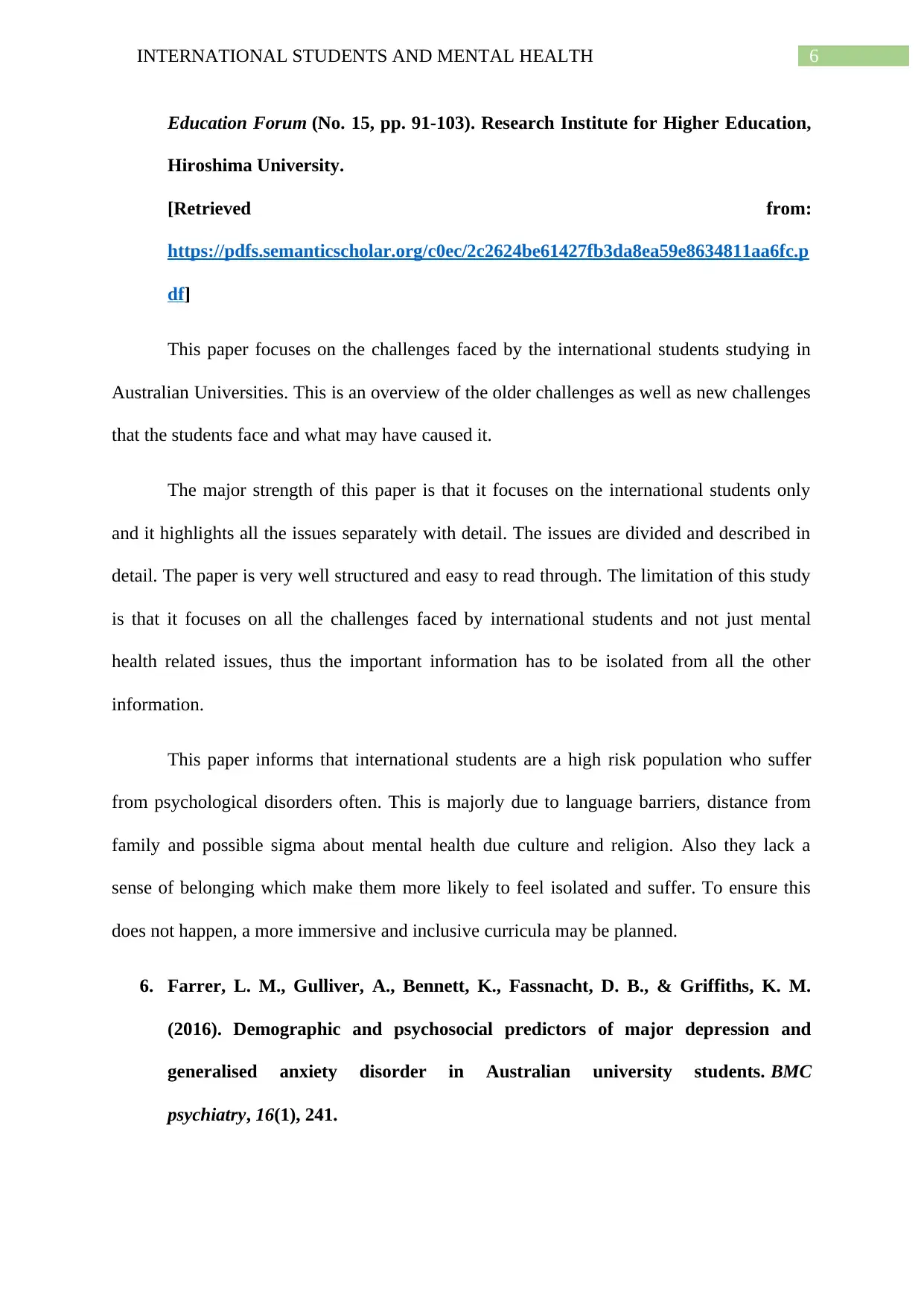
6INTERNATIONAL STUDENTS AND MENTAL HEALTH
Education Forum (No. 15, pp. 91-103). Research Institute for Higher Education,
Hiroshima University.
[Retrieved from:
https://pdfs.semanticscholar.org/c0ec/2c2624be61427fb3da8ea59e8634811aa6fc.p
df]
This paper focuses on the challenges faced by the international students studying in
Australian Universities. This is an overview of the older challenges as well as new challenges
that the students face and what may have caused it.
The major strength of this paper is that it focuses on the international students only
and it highlights all the issues separately with detail. The issues are divided and described in
detail. The paper is very well structured and easy to read through. The limitation of this study
is that it focuses on all the challenges faced by international students and not just mental
health related issues, thus the important information has to be isolated from all the other
information.
This paper informs that international students are a high risk population who suffer
from psychological disorders often. This is majorly due to language barriers, distance from
family and possible sigma about mental health due culture and religion. Also they lack a
sense of belonging which make them more likely to feel isolated and suffer. To ensure this
does not happen, a more immersive and inclusive curricula may be planned.
6. Farrer, L. M., Gulliver, A., Bennett, K., Fassnacht, D. B., & Griffiths, K. M.
(2016). Demographic and psychosocial predictors of major depression and
generalised anxiety disorder in Australian university students. BMC
psychiatry, 16(1), 241.
Education Forum (No. 15, pp. 91-103). Research Institute for Higher Education,
Hiroshima University.
[Retrieved from:
https://pdfs.semanticscholar.org/c0ec/2c2624be61427fb3da8ea59e8634811aa6fc.p
df]
This paper focuses on the challenges faced by the international students studying in
Australian Universities. This is an overview of the older challenges as well as new challenges
that the students face and what may have caused it.
The major strength of this paper is that it focuses on the international students only
and it highlights all the issues separately with detail. The issues are divided and described in
detail. The paper is very well structured and easy to read through. The limitation of this study
is that it focuses on all the challenges faced by international students and not just mental
health related issues, thus the important information has to be isolated from all the other
information.
This paper informs that international students are a high risk population who suffer
from psychological disorders often. This is majorly due to language barriers, distance from
family and possible sigma about mental health due culture and religion. Also they lack a
sense of belonging which make them more likely to feel isolated and suffer. To ensure this
does not happen, a more immersive and inclusive curricula may be planned.
6. Farrer, L. M., Gulliver, A., Bennett, K., Fassnacht, D. B., & Griffiths, K. M.
(2016). Demographic and psychosocial predictors of major depression and
generalised anxiety disorder in Australian university students. BMC
psychiatry, 16(1), 241.
Paraphrase This Document
Need a fresh take? Get an instant paraphrase of this document with our AI Paraphraser
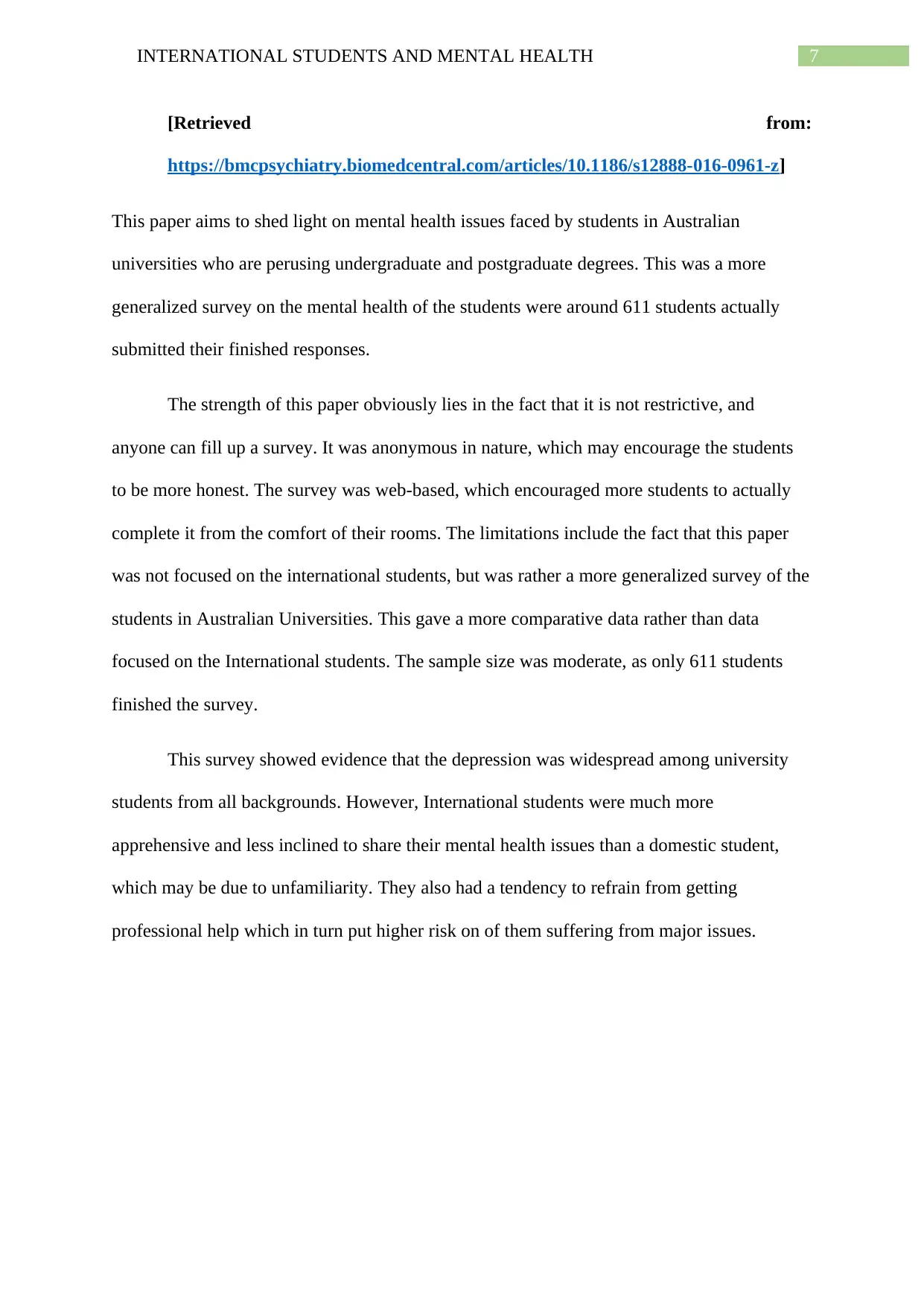
7INTERNATIONAL STUDENTS AND MENTAL HEALTH
[Retrieved from:
https://bmcpsychiatry.biomedcentral.com/articles/10.1186/s12888-016-0961-z]
This paper aims to shed light on mental health issues faced by students in Australian
universities who are perusing undergraduate and postgraduate degrees. This was a more
generalized survey on the mental health of the students were around 611 students actually
submitted their finished responses.
The strength of this paper obviously lies in the fact that it is not restrictive, and
anyone can fill up a survey. It was anonymous in nature, which may encourage the students
to be more honest. The survey was web-based, which encouraged more students to actually
complete it from the comfort of their rooms. The limitations include the fact that this paper
was not focused on the international students, but was rather a more generalized survey of the
students in Australian Universities. This gave a more comparative data rather than data
focused on the International students. The sample size was moderate, as only 611 students
finished the survey.
This survey showed evidence that the depression was widespread among university
students from all backgrounds. However, International students were much more
apprehensive and less inclined to share their mental health issues than a domestic student,
which may be due to unfamiliarity. They also had a tendency to refrain from getting
professional help which in turn put higher risk on of them suffering from major issues.
[Retrieved from:
https://bmcpsychiatry.biomedcentral.com/articles/10.1186/s12888-016-0961-z]
This paper aims to shed light on mental health issues faced by students in Australian
universities who are perusing undergraduate and postgraduate degrees. This was a more
generalized survey on the mental health of the students were around 611 students actually
submitted their finished responses.
The strength of this paper obviously lies in the fact that it is not restrictive, and
anyone can fill up a survey. It was anonymous in nature, which may encourage the students
to be more honest. The survey was web-based, which encouraged more students to actually
complete it from the comfort of their rooms. The limitations include the fact that this paper
was not focused on the international students, but was rather a more generalized survey of the
students in Australian Universities. This gave a more comparative data rather than data
focused on the International students. The sample size was moderate, as only 611 students
finished the survey.
This survey showed evidence that the depression was widespread among university
students from all backgrounds. However, International students were much more
apprehensive and less inclined to share their mental health issues than a domestic student,
which may be due to unfamiliarity. They also had a tendency to refrain from getting
professional help which in turn put higher risk on of them suffering from major issues.
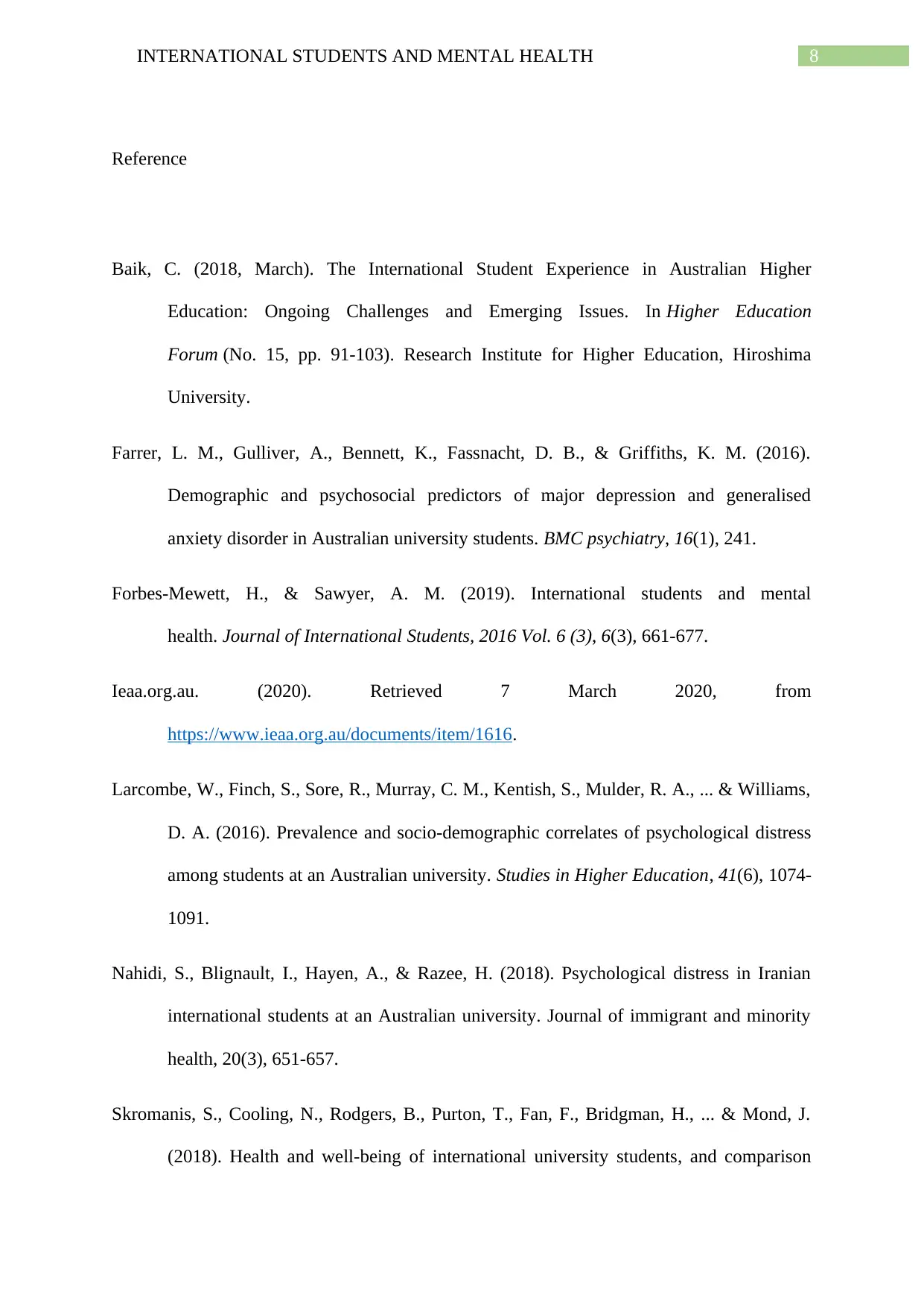
8INTERNATIONAL STUDENTS AND MENTAL HEALTH
Reference
Baik, C. (2018, March). The International Student Experience in Australian Higher
Education: Ongoing Challenges and Emerging Issues. In Higher Education
Forum (No. 15, pp. 91-103). Research Institute for Higher Education, Hiroshima
University.
Farrer, L. M., Gulliver, A., Bennett, K., Fassnacht, D. B., & Griffiths, K. M. (2016).
Demographic and psychosocial predictors of major depression and generalised
anxiety disorder in Australian university students. BMC psychiatry, 16(1), 241.
Forbes-Mewett, H., & Sawyer, A. M. (2019). International students and mental
health. Journal of International Students, 2016 Vol. 6 (3), 6(3), 661-677.
Ieaa.org.au. (2020). Retrieved 7 March 2020, from
https://www.ieaa.org.au/documents/item/1616.
Larcombe, W., Finch, S., Sore, R., Murray, C. M., Kentish, S., Mulder, R. A., ... & Williams,
D. A. (2016). Prevalence and socio-demographic correlates of psychological distress
among students at an Australian university. Studies in Higher Education, 41(6), 1074-
1091.
Nahidi, S., Blignault, I., Hayen, A., & Razee, H. (2018). Psychological distress in Iranian
international students at an Australian university. Journal of immigrant and minority
health, 20(3), 651-657.
Skromanis, S., Cooling, N., Rodgers, B., Purton, T., Fan, F., Bridgman, H., ... & Mond, J.
(2018). Health and well-being of international university students, and comparison
Reference
Baik, C. (2018, March). The International Student Experience in Australian Higher
Education: Ongoing Challenges and Emerging Issues. In Higher Education
Forum (No. 15, pp. 91-103). Research Institute for Higher Education, Hiroshima
University.
Farrer, L. M., Gulliver, A., Bennett, K., Fassnacht, D. B., & Griffiths, K. M. (2016).
Demographic and psychosocial predictors of major depression and generalised
anxiety disorder in Australian university students. BMC psychiatry, 16(1), 241.
Forbes-Mewett, H., & Sawyer, A. M. (2019). International students and mental
health. Journal of International Students, 2016 Vol. 6 (3), 6(3), 661-677.
Ieaa.org.au. (2020). Retrieved 7 March 2020, from
https://www.ieaa.org.au/documents/item/1616.
Larcombe, W., Finch, S., Sore, R., Murray, C. M., Kentish, S., Mulder, R. A., ... & Williams,
D. A. (2016). Prevalence and socio-demographic correlates of psychological distress
among students at an Australian university. Studies in Higher Education, 41(6), 1074-
1091.
Nahidi, S., Blignault, I., Hayen, A., & Razee, H. (2018). Psychological distress in Iranian
international students at an Australian university. Journal of immigrant and minority
health, 20(3), 651-657.
Skromanis, S., Cooling, N., Rodgers, B., Purton, T., Fan, F., Bridgman, H., ... & Mond, J.
(2018). Health and well-being of international university students, and comparison
⊘ This is a preview!⊘
Do you want full access?
Subscribe today to unlock all pages.

Trusted by 1+ million students worldwide

9INTERNATIONAL STUDENTS AND MENTAL HEALTH
with domestic students, in Tasmania, Australia. International journal of
environmental research and public health, 15(6), 1147.
with domestic students, in Tasmania, Australia. International journal of
environmental research and public health, 15(6), 1147.
1 out of 10